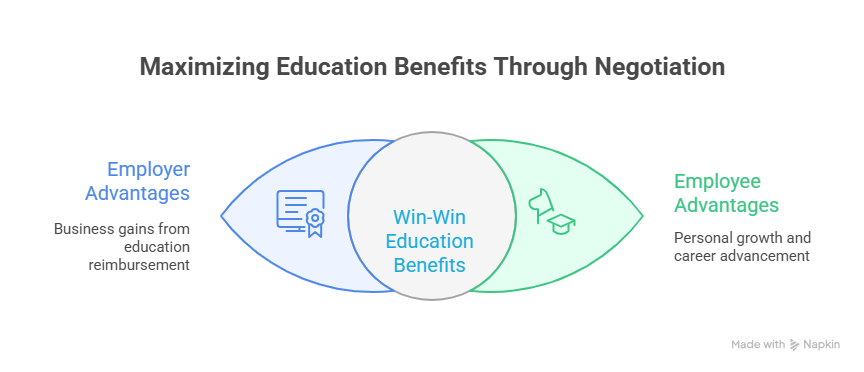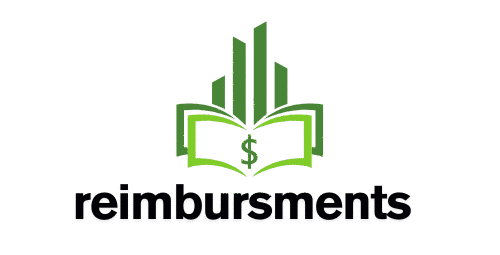Did you know that more than 60% of US large corporations have some kind of tuition reimbursement program in place? The purpose of this benefit is to boost job satisfaction and encourage professional development.
These initiatives are a part of a larger policy that reimburses employees for their education, enabling them to continue their education while they are still employed.
Under these policies, employers usually cover a variety of courses and degree programs, ranging from advanced degrees to vocational training. Businesses hope to increase productivity and retention by investing in the training of their employees.
Understanding Your Employee Education Reimbursement Policy
Policies that reimburse education are being adopted by employers more frequently in an effort to draw in, keep, and develop talent. These regulations improve career advancement and job satisfaction, making them an essential component of employee benefits.
What Are Education Reimbursement Programs?
Employer-funded initiatives known as education reimbursement programs are intended to encourage staff members to pursue additional training or education. Tuition, books, and other necessary materials are just a few of the educational costs that these programs can pay for. Employers show their dedication to the advancement of their workforce by funding their employees’ education.
Benefits for Both Employees and Employers
Programs for education reimbursement offer a variety of advantages. These programs give workers the opportunity to develop their skills, which can lead to opportunities for career advancement. Increased productivity, enhanced job satisfaction, and higher employee retention rates are among the advantages for employers. Employers can cultivate a workforce that is more skilled and motivated by promoting employee education.
What’s Typically Covered in Education Reimbursement Programs
Employees can maximize their benefits by being aware of what is covered by education reimbursement programs. These initiatives, which provide funding for a range of educational costs, are intended to assist staff members in their academic and professional growth.
Tuition and Academic Course Fees
Covering tuition and academic course fees is the main function of education reimbursement programs. Undergraduate, graduate, and professional degree programs may fall under this category. Companies may pay back a set amount for each course or a portion of the tuition. For example, some businesses offer up to $5,000 in annual reimbursement for pertinent courses under their corporate training policy.
Books and Required Educational Materials
Many programs pay for books and other necessary educational materials in addition to tuition. This can be a substantial cost, particularly for programs that call for specialized hardware or software. To find out what is covered, employees should review their employer’s policy.
Professional Certifications and Training
Professional certifications and training are frequently covered by education reimbursement programs. This can include training programs, workshops, and certification tests that improve a worker’s abilities and future employment opportunities. For instance, a business may pay for a worker’s project management training.
Common Limitations and Restrictions
Programs for education reimbursement are advantageous, but they frequently have restrictions and limitations. These may include restrictions on the kinds of courses that can be taken, minimum grade requirements, or caps on reimbursement amounts. To get the most out of their benefits, employees should be aware of these specifics.
How to Maximize Your Employer’s Education Benefits
Knowing the ins and outs of your company’s tuition reimbursement policies is crucial if you want to maximize your employer’s education benefits. You can make well-informed decisions regarding your education and professional development if you are familiar with these guidelines.
Understanding Eligibility Requirements
Employer-specific eligibility requirements for education benefits usually include being a full-time employee or having worked for the company for a specific amount of time. For precise information, consult your employee handbook or HR portal.
Application Process and Important Deadlines
A form and supporting documentation, such as course schedules and tuition receipts, are typically required as part of the application process for education benefits. To prevent losing out on benefits, be mindful of the application and payment deadlines.
Tax Implications of Education Assistance
Benefits from education assistance may have tax ramifications. Education assistance up to $5,250 is typically tax-free. To find out how your benefits will be taxed, speak with a tax expert.
Negotiating Better Education Benefits
Talk to your employer about negotiating if you think your education benefits are inadequate. Make a compelling argument by emphasizing the advantages of education reimbursement for the business and for you.
| Benefit | Description | Typical Limitations |
|---|---|---|
| Tuition Reimbursement | Covers tuition fees for approved courses | $5,000 per year |
| Books and Materials | Covers costs of required books and materials | $500 per course |
| Professional Certifications | Covers fees for professional certification programs | $2,000 per certification |

Conclusion
Gaining an understanding of your company’s education sponsorship policy can significantly impact both your professional and personal development. As previously mentioned, employee education reimbursement programs provide a number of advantages, ranging from professional certifications and training to tuition and academic course fees.
Employees can improve their career prospects, develop new skills, and help their company succeed by investigating and taking advantage of these advantages. Reviewing your company’s education reimbursement policy is crucial, as is being aware of the eligibility requirements, the application procedure, and any potential tax ramifications.
Employers can benefit from a more knowledgeable and driven workforce, and employees can take charge of their career paths with the correct education sponsorship policy in place. Investigate your options for educational benefits by taking the first step right now.
FAQ
What is an employee education reimbursement policy?
An employee education reimbursement policy is a program that employers provide to assist staff members in covering educational costs associated with their work or professional development, such as tuition, fees, and materials.
Are all education expenses covered under the tuition reimbursement program?
No, not all costs associated with education are covered. Employer education benefits usually pay for tuition, fees, and necessary course materials; however, they might not cover other costs, such as living expenses or transportation.
How do I know if I’m eligible for the education reimbursement program?
Employers have different eligibility requirements, but generally speaking, workers need to be in good standing, have been with the company for a specific amount of time, and be pursuing education relevant to their work or professional growth.
Can I use the education reimbursement program for online courses or certifications?
It’s best to check with your HR department to make sure, but many employers do offer coverage for online courses and certifications as part of their education assistance policy.
Are there any tax implications for using the education reimbursement program?
Up to a certain amount ($5,250 in 2023), education assistance benefits are typically tax-free; however, it’s always best to speak with a tax expert to learn the precise tax implications for your circumstances.
Can I negotiate better education benefits with my employer?
Better education benefits can be negotiated, especially if you can show how the company will gain from the education. Talking about it with your supervisor or HR department is worthwhile.
What is the typical process for applying for education reimbursement?
The specifics of the application process can change based on the employer’s corporate training reimbursement policies, but generally speaking, it entails submitting a form, supplying proof of enrollment, and providing receipts for expenses.
Are there any limitations or restrictions on the types of courses or programs that are covered?
Indeed, employers frequently impose restrictions or limitations on the kinds of programs or courses that can be taken, such as requiring that the education be relevant to the worker’s current position or professional growth.




